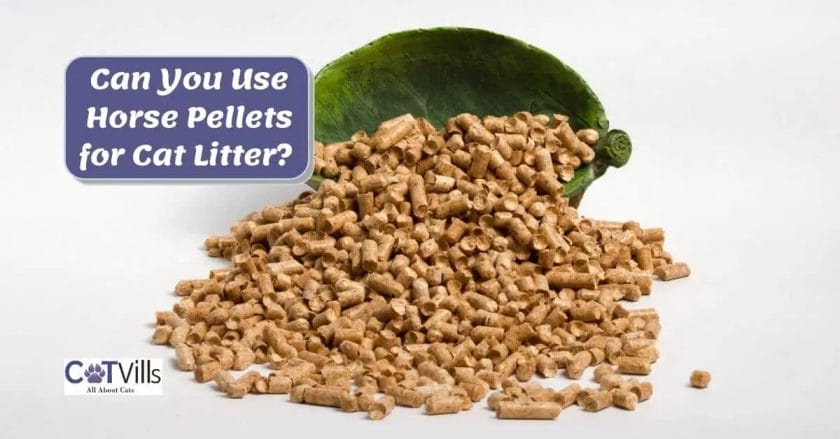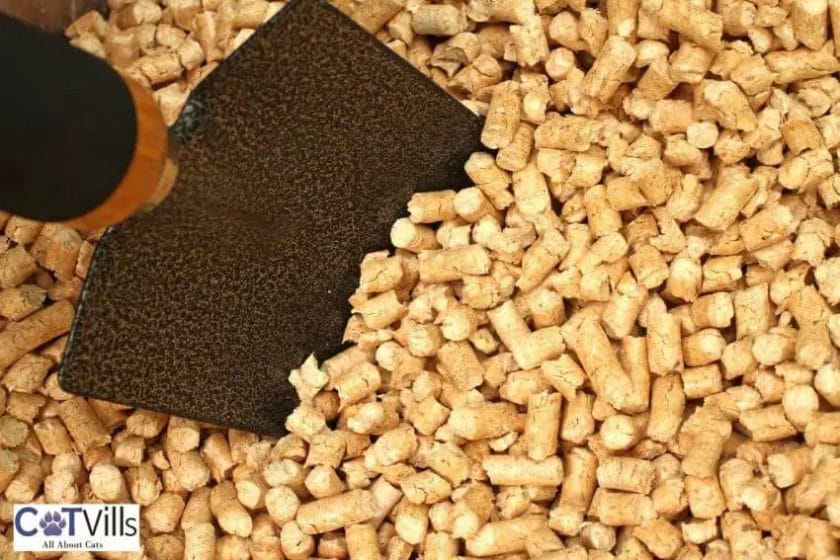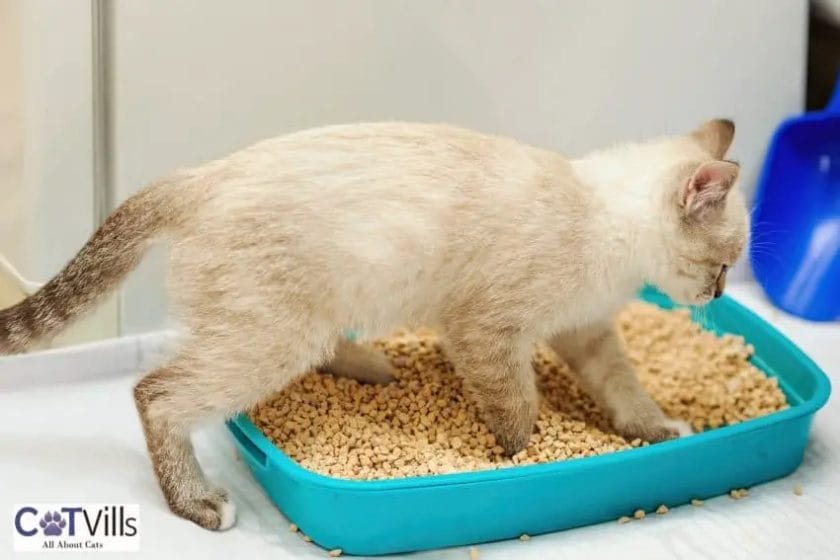Using horse pellets as cat litter can be a cost-effective and eco-friendly alternative to traditional cat litter. Horse pellets are typically made from natural materials like sawdust or wood shavings, which can effectively absorb moisture and control odors. However, it’s important to note that not all horse pellets are suitable for cats.
Before using horse pellets as cat litter, make sure to check the ingredients and ensure they are free from any harmful chemicals or additives. Additionally, consider your cat’s preferences and comfort as some cats may find the texture or scent of horse pellets unpleasant. Always monitor your cat’s behavior and consult with a veterinarian if you have any concerns.

How to Properly Prepare Horse Pellets for Cat Litter Use
In this section, we will discuss the steps involved in preparing horse pellets for use as cat litter. Horse pellets are an effective and affordable alternative to traditional cat litter. Not only are they environmentally friendly, but they also have excellent odor control properties. However, before using horse pellets as cat litter, it is essential to properly prepare them to ensure optimal performance and comfort for your feline friend.
Step 1: Choose the Right Horse Pellets
The first step in preparing horse pellets for cat litter use is to select the right type of pellets. Look for horse bedding pellets that are made from 100% natural materials, such as wood or paper. Avoid pellets that contain additives or chemicals that could be harmful to your cat’s health.
Step 2: Test for Allergies
Before introducing horse pellets as cat litter, it is crucial to test for any potential allergies or sensitivities. Sprinkle a small amount of the pellets in your cat’s litter box and observe their behavior and any signs of discomfort. If your cat shows any adverse reactions, such as excessive sneezing or coughing, discontinue use and consult a veterinarian.
Step 3: Moisture Activation
Horse pellets are designed to absorb moisture and control odor, but they need to be properly activated before use. To activate the pellets, add a small amount of water to the litter box, allowing the pellets to expand and break down into a more absorbent material. Stir the pellets occasionally to ensure even moisture distribution.
Step 4: Allow for Drying Time
After activating the horse pellets, allow them to dry for a short period before your cat starts using the litter box. This will ensure that the pellets have absorbed the right amount of moisture and provide maximum odor control. Drying time can vary depending on the climate and the level of moisture added. Monitor the pellets until they are dry to the touch.
Step 5: Introduce to Your Cat
Once the horse pellets are dry, it’s time to introduce them to your cat. Place your cat in the litter box and allow them to explore and become familiar with the new litter. Some cats may take some time to adjust to the new texture and scent. Make sure to clean the litter box regularly to maintain cleanliness and freshness.
Step 6: Monitor and Maintain
After switching to horse pellets as cat litter, monitor your cat’s behavior and litter box habits. Ensure that your cat is comfortable using the new litter and that there are no signs of discomfort or irritation. Scoop the litter box daily and add fresh pellets as needed to maintain cleanliness and odor control.
In summary, properly preparing horse pellets for cat litter use involves selecting the right type of pellets, testing for allergies, activating the pellets with moisture, allowing for drying time, introducing the litter to your cat, and monitoring and maintaining the litter box. Following these steps will help ensure a comfortable and odor-free environment for your feline companion.

Comparison of Horse Pellets with Traditional Cat Litter Options
Choosing the right cat litter is an important decision for any cat owner. With so many options available, it can be overwhelming to determine which one is best for your feline friend. In recent years, horse pellets have gained popularity as an alternative to traditional cat litter. In this section, we will compare horse pellets with other commonly used cat litter options to help you make an informed decision.
1. Horse Pellets
Horse pellets, also known as wood pellets, are made from compressed sawdust. They are typically used as bedding for horses but have gained traction as a cat litter option for their natural properties. Horse pellets are highly absorbent and have excellent odor control capabilities. They are also biodegradable, making them an environmentally friendly choice.
One of the key advantages of horse pellets is their cost-effectiveness. They are generally more affordable than other cat litter options, especially if you purchase them in bulk. Horse pellets also tend to last longer as they require less frequent changing compared to other litters.
2. Clay Cat Litter
Clay cat litter is one of the most commonly used types of cat litter. It is made from natural clay minerals that clump together when exposed to moisture. This clumping action helps to contain odors and makes cleaning the litter box easier.
While clay cat litter has good odor control properties, it can be dusty and may cause respiratory issues in some cats, especially those with respiratory conditions. Additionally, clay cat litter is not biodegradable and contributes to environmental waste.
3. Silica Gel Cat Litter
Silica gel cat litter is another popular option among cat owners. It is made from silica crystals that absorb urine and trap odors. Silica gel litter is lightweight and has excellent moisture absorption capabilities.
One of the downsides of silica gel litter is its higher cost compared to other options. It also needs to be changed more frequently as the crystals can only hold a certain amount of moisture. Silica gel litter may also be less environmentally friendly as it is not biodegradable.
4. Recycled Paper Cat Litter
Recycled paper cat litter is made from shredded paper products such as newspapers or cardboard. It is highly absorbent and has good odor control properties. Recycled paper litter is also biodegradable and eco-friendly.
However, recycled paper litter may not clump as well as other types of litter, making it harder to clean. It may also be less effective at controlling strong odors. Additionally, some cats may be reluctant to use paper litter due to its texture.
When comparing horse pellets with traditional cat litter options, it is clear that horse pellets offer several advantages. They are cost-effective, highly absorbent, and have excellent odor control capabilities. Additionally, horse pellets are biodegradable and environmentally friendly. While traditional cat litters such as clay, silica gel, and recycled paper have their own benefits, horse pellets provide a viable alternative for cat owners seeking a natural and economical option.

Tips for Transitioning Your Cat to Horse Pellet Litter
If you’re looking for an eco-friendly alternative to traditional cat litter, horse pellet litter can be a great option. Made from compressed wood or paper, horse pellet litter is not only biodegradable but also absorbent and odor-controlling. However, transitioning your cat from regular litter to horse pellet litter may require some time and patience. Here are some tips to help you make the switch smoothly:
1. Introduce the new litter gradually
Instead of completely replacing your cat’s regular litter with horse pellet litter overnight, start by mixing a small amount of the pellet litter into their existing litter. This allows your cat to gradually get used to the new texture and scent. Over the course of several days, gradually increase the amount of horse pellet litter and decrease the amount of regular litter until you’ve fully transitioned.
2. Consider your cat’s preferences
Every cat is unique, and some may have preferences when it comes to litter. If your cat is resistant to the new litter, try experimenting with different types of horse pellet litter. Some brands offer pellets made from different materials, such as wood or paper, which can have different textures and scents. Finding the right type of pellet litter that suits your cat’s preferences can make the transition easier.
3. Maintain cleanliness
Just like with any litter, proper maintenance and cleanliness are essential. Horse pellet litter needs to be sifted or scooped regularly to remove waste. The pellets break down when they come into contact with moisture, forming sawdust. Be sure to remove any soiled pellets or sawdust promptly to keep the litter box clean and odor-free. Regular cleaning will help your cat adjust to the new litter and ensure their comfort.
4. Provide multiple litter boxes
If you have multiple cats or a larger home, it’s a good idea to have multiple litter boxes available. This is especially important during the transition period when some cats may not immediately take to the new litter. Having multiple litter boxes ensures that each cat has access to a litter box with their preferred litter, reducing stress and potential litter box accidents.
5. Use positive reinforcement
Cats respond well to positive reinforcement, so reward your cat with treats, praise, or playtime whenever they use the horse pellet litter. This will help them associate the new litter with positive experiences and encourage them to continue using it. Avoid scolding or punishing your cat if they have accidents during the transition period, as this can create negative associations with the litter box.
6. Be patient and monitor your cat’s behavior
Transitioning to a new litter can take time, and some cats may take longer to adjust than others. Monitor your cat’s behavior during the transition period to ensure they are using the litter box consistently and not showing signs of discomfort or stress. If you notice any issues, such as excessive scratching or avoiding the litter box altogether, consult with your veterinarian for further guidance.
In summary, transitioning your cat to horse pellet litter requires a gradual introduction, consideration of your cat’s preferences, maintaining cleanliness, providing multiple litter boxes, using positive reinforcement, and being patient. By following these tips, you can successfully switch to an eco-friendly and effective litter option for your feline friend.
Common Concerns and FAQs about Using Horse Pellets as Cat Litter
Using horse pellets as cat litter is a popular alternative to traditional clay or crystal litter. However, many cat owners have questions and concerns about this unconventional choice. In this section, we address some of the common concerns and frequently asked questions about using horse pellets as cat litter.
1. Are horse pellets safe for cats?
Yes, horse pellets are generally safe for cats to use as litter. They are made from compressed sawdust or wood fibers and do not contain harmful chemicals. However, it’s essential to choose pellets that are specifically designed for horse bedding and not treated with any additives or substances that could be harmful to cats.
2. Can horse pellets cause allergies in cats?
While horse pellets are generally hypoallergenic, some cats may have sensitivities or allergies to specific types of wood. It’s recommended to observe your cat’s behavior and health after switching to horse pellets as litter. If you notice any signs of allergies such as excessive scratching, sneezing, or respiratory issues, it may be best to switch to a different type of litter.
3. How do I introduce my cat to horse pellets?
Introducing your cat to horse pellets as litter may require some patience and gradual transition. Start by mixing a small amount of horse pellet litter with your cat’s usual litter, gradually increasing the ratio of pellets over time. This allows your cat to become accustomed to the new texture and scent without feeling overwhelmed. Cats are creatures of habit, so a gradual transition is often more successful.
4. Do horse pellets control odor effectively?
Yes, horse pellets are known for their superior odor control properties. When the pellets come into contact with moisture, they disintegrate into sawdust, which helps absorb and control odors. Regular scooping of soiled pellets and proper litter box maintenance can further enhance the odor control capabilities of horse pellet litter.
5. How often should I change the horse pellet litter?
The frequency of litter changes depends on a few factors, such as the number of cats in your household and their litter box habits. Generally, it’s recommended to fully replace the horse pellet litter every 1-2 weeks. However, you should monitor the litter box regularly and make additional changes as needed to maintain cleanliness and freshness.
6. Can horse pellets be flushed down the toilet?
No, horse pellets should not be flushed down the toilet. Unlike some biodegradable cat litters, horse pellets do not break down quickly in water and can cause plumbing issues. It’s best to dispose of used horse pellet litter by placing it in a sealed bag and disposing of it in your regular trash.
7. Are horse pellets more cost-effective than traditional cat litters?
Yes, using horse pellets as cat litter can be more cost-effective in the long run. While the initial purchase price may be slightly higher compared to traditional litters, horse pellets tend to last longer and require less frequent changing. Additionally, they can often be purchased in bulk, providing even more savings.
8. Can horse pellets be used with automatic litter boxes?
Yes, horse pellets can be used with some automatic litter boxes. However, it’s essential to check the manufacturer’s guidelines for compatibility. Some automatic litter boxes may not work well with horse pellets due to their larger size and different texture.
In summary, using horse pellets as cat litter can be a safe and cost-effective alternative to traditional options. However, it’s important to consider your cat’s individual needs and preferences. Monitoring your cat’s behavior and making necessary adjustments will ensure a smooth transition and a comfortable litter box experience for your furry friend.
FAQs
Can I use horse pellets for cat litter?
No, it is not recommended to use horse pellets for cat litter. Horse pellets are designed for horses and can be harmful if ingested or inhaled by cats. It is better to use cat-specific litter that is safe for your pet.
Conclusion
In conclusion, while horse pellets may seem like a potentially affordable and eco-friendly option for cat litter, it is not recommended. The composition and texture of horse pellets are not ideal for a cat’s sensitive paws and may cause discomfort or irritation. Additionally, horse pellets are not designed to control odor effectively or clump, making it difficult to maintain a clean and odor-free litter box for your cat. It is always best to choose a cat-specific litter that is designed to meet your feline friend’s needs, providing them with a safe and hygienic environment.
